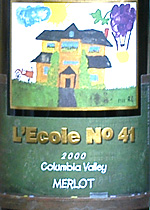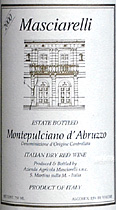|
High or low? Remember last winter's publicity flurry over "Two Buck Chuck," the joking nickname for the Charles Shaw line of wines that sold for just $2 a bottle at Trader Joe's food-specialty stores in California and a still-affordable $4 at the chain's shops in other states? The fallout continues, according to an article in this month's edition of California Farmer magazine, forwarded to me by a wine-loving friend. Writer Len Richardson, in an article headlined "Hijacked by Two Buck Chuck," reports that market research shows very inexpensive wines - "Chuck" and its competitors - are cannibalizing sales from more expensive wines but not bringing many new wine drinkers into the market. "The research in part confirms what many in the industry believed or feared - that Two Buck Chuck and other wines in the SVW ("Super Value Wines") category are drawing sales from more expensive wines, mainly those in the $5 to $10 range," Richardson wrote. "It also reports that these low-priced wines are attracting very few new wine drinkers into the category, but instead are appealing primarily to established wine drinkers." "Super Value Wines" are defined as "varietal" wines - labeled with the name of the grape, such as Chardonnay or Merlot - sold as table wine in traditional 750-ml wine bottles. "Short-term, it's clearly bad news for the wine industry that Super Value Wines are causing consumers to trade down," an industry analyst told Richardson. "But there's some long-term good news for the industry as well - the research clearly shows that the new price point is causing consumers to purchase more wine." Tom Restaino, managing partner of industry analyst BRS Group, added that the Two Buck Chuck phenomenon suggests American consumers may be ready to accept an American equivalent of the French "vin ordinaire" for everyday enjoyment. "For years, the wine industry has been trying to establish wine as an everyday beverage. Now the consumer is pointing the way for us as to how to accomplish that." The deeper question that all these issues raise, it seems to me, is whether "you get what you pay for" is a valid principle when it comes to quality wines. You may recall that I got my hands on a few "Two Buck Chuck" varietals last winter and taste-tested them in "blind" tastings against somewhat more expensive wines of the same varieties. My conclusion: They were certainly worth $2 or even $4, and significantly exceeded the quality of most jug wines and boxed wines in that price range. Frankly, they are probably as good as some basic "fighting varietal" labels from California, France, Australia and elsewhere that are overpriced in the $6 range. But they couldn't quite match up to $10 wines, showing their low-rent heritage by their relative softness, and their lack of structure and real varietal character. As a wine lover who enjoys wine as a hobby, I want something more than innocuous simplicity in my wine, and I'm willing to spend a few dollars more to get it. But I'm also critical in the quest for value, and would rather have a good $7 wine than a boring $14 bottle ... and have the pleasure of telling you about my findings in a daily wine report. More in the realm of casual inquiry than serious research, I decided to open a good cheap wine and a good pricey item over the past couple of nights. First we enjoyed a classy but expensive Washington State Merlot from a respected maker, L'Ecole No. 41. It's not quite ostentatious but certainly exceeds my usual limit for everyday wine with its $29 price tag. The following evening, I pulled the cork from a downscale, simple but pleasant and well-structured Italian red, a Montepulciano d'Abruzzo from Masciarelli that cost only $7 - one-fourth the toll for the Merlot. Was the costly Washington wine four times better than the cheap Italian? I can't honestly say that. But was the Merlot "worth it"? It was certainly a subtle, complex, interesting and ageworthy wine, and I very much enjoyed sipping it with and after dinner on a long summer evening at home with my bride. "Worth it," I think, is one of those imponderable, irrational decisions that we all have to make for ourselves.  L'Ecole No. 41 2000 Columbia Valley Merlot ($28.99)
L'Ecole No. 41 2000 Columbia Valley Merlot ($28.99)
Inky dark reddish purple, almost opaque. Deep, plummy fruit aromas add complex nuances of spice and smoke. The flavor is ripe, juicy and tart, like biting into a perfectly fresh plum: Abundant fruit polishes the edges of a firm acidic structure; tannins are present but soft and smooth. Dark fruits, cleansing acidity and a gently astringent edge persist in a very long finish. A "serious" Merlot that will gain additional complexity with careful cellaring. (Aug. 11, 2003) FOOD MATCH: Chosen to match the flavors in a dish created for a Bourbon-cookery article: Chicken pieces coated with spiced pecans on a sweet-spicy Bourbon sauce. VALUE: Not a cheap wine, but appropriately priced for its quality level, particularly when compared with the prices of Merlot-based Right Bank Bordeaux or even some of its more "cultish" competitors from Washington State and California. WHEN TO DRINK: Drinkable now, especially with food, but its brooding nature and soft tannins suggest it will improve with a few years' cellar time.
WEB LINK: You'll find the L'Ecole No. 41 Website at  Masciarelli 2000 Montepulciano d'Abruzzo ($7)
Masciarelli 2000 Montepulciano d'Abruzzo ($7)
Very dark garnet, showing flashes of reddish-purple against the light. Pleasant black-cherry and spice aromas, typical of the Montepulciano grape, are reflected in its tart, sour-cherry flavor shaped by tangy lemon-squirt acidity. Simple but nicely balanced, fine with food. U.S. importer: Masciarelli Wine Co., Weymouth, Mass. (Aug. 12, 2003) FOOD MATCH: Couldn't ask for a better match with thick, juicy burgers made from locally produced beef, sandwiched with thick slices of fresh garden tomato. VALUE: Hard to beat at this low-end price. WHEN TO DRINK: Not made for aging, but will certainly keep on a wine rack for a year or two.
WEB LINK: Masciarelli's Website is available in five languages. For English, click to: Administrivia To subscribe or unsubscribe from The 30 Second Wine Advisor, change your E-mail address, or for any other administrative matters, please use the individualized hotlink found at the end of your E-mail edition. If this is not practical, contact me by E-mail at wine@wineloverspage.com, including the exact E-mail address that you used when you subscribed, so I can find your record. We do not use our E-mail list for any other purpose and will never give or sell your name or E-mail address to anyone. I welcome feedback, suggestions, and ideas for future columns. To contact me, please send E-mail to wine@wineloverspage.com All the wine-tasting reports posted here are consumer-oriented. In order to maintain objectivity and avoid conflicts of interest, I purchase all the wines I rate at my own expense in retail stores and accept no samples, gifts or other gratuities from the wine industry.
Wednesday, Aug. 13, 2003 |




